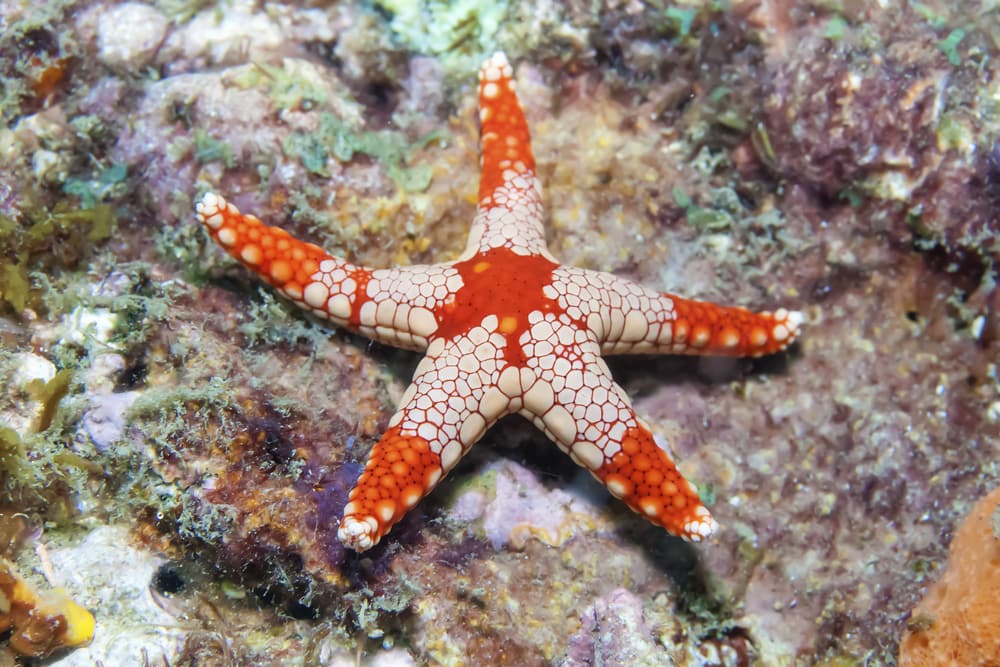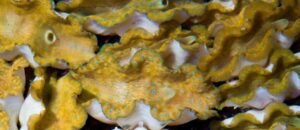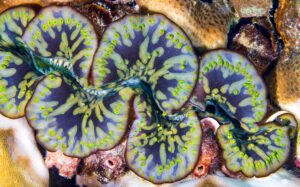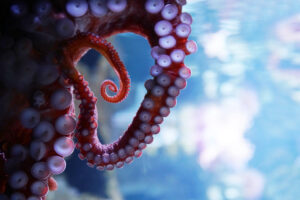When it comes to marine aquariums, and reef tank setups in particular, the number of fish you can realistically keep in the system is limited. But, the variety and number of invertebrates you can keep are almost endless. Almost. Even tanks as small as five gallons can house a few Sexy Shrimp and micro brittle starfish. There are so many invertebrates collected and bred for the aquarium trade that both beginners and experts are able to find new species that interest them and test their husbandry skills. For example, a beginner may find interest in keeping a pair of Fire Shrimp, while the expert aquarist with years of husbandry under his or her belt may want to try their hand in breeding Peppermint Shrimp or Pom Pom Crabs. One of the most popular groups of invertebrates are starfish, and it seems that every aquarist wants one or two in their tank. Children love them, and the fish store employee promised they are low maintenance, eat algae, and are incredibly easy to take care of, so why not? Unfortunately, there are a few species that are fairly inexpensive and easy to find, but don’t do well long term in aquariums. A few of these have barely been studied at all by the scientific community, and nobody knows what their real diet consists of. While certain stars can make excellent clean up crew members, some popular species should be left in the wild. If you educate yourself before you buy, you can make sure you are purchasing the best fit for your aquarium.
Linckia Stars
Linckia Starfish are some of the most beautiful species commonly available. Most popular are bright blue, orange, red, and purple Linckias. Many different species of Linckia are often sold as each other, and there is some color variation that can make one species look like another and be almost indistinguishable. Thankfully, most are completely reef and fish safe, with a few assumed to eat sponges and tunicates. But, Purple Linckia in particular get a bad rap due to so many other species being sold as Linckia teres. Many of these other “Purple Linckia” species are predatory and may decide to dine on clams, other starfish, coral, and more. Get comfortable with identifying true Linckias before going to the fish shop to purchase one.
Due to the sensitive nature of these stars, I cannot recommend purchasing one online. Shipping is incredibly hard on this animal, and many die from simply being in a bag and shipped a few states away. It is always recommended to purchase Linckias in person after you get the chance to assess their condition before committing to one. Watch out for white or grey patches, as this is the beginning stages of deterioration and death. While some species do have a mottled appearance, the solid colored species should be uniform in color. These starfish are also typically nocturnal, so it is best to shop for them near closing time as bright lights send Linckias into hiding during the day. You should wait to see if the star becomes more active and moves around when the lighting dims or turns off. If it is active, double check that his limbs are all relatively stiff and mobile, as a limp arm or two indicates deterioration within the next week. And finally, ask to see the underside of the Linckia, as small parasitic snails are commonly hitchhiking on the bottoms of their legs. They appear as small white shells that burrow into the flesh of the star. While these snails are not a huge deal and don’t affect the overall health of the star very much, if at all, it is better to choose an uninfected specimen if possible. If the starfish you are considering has met these criteria, it is reasonable to assume it is healthy. Acclimation to your tank needs to be slow and steady, with most owners recommending a two or three hour drip acclimation.
[CInverts]
Lastly, Linckia Starfish require a large reef tank setup. We do not know what their diet actually consists of in the wild, but we do know that they appear to consume bacterial and algae films, sponges, decaying organics, small dead mollusks, and possibly floating particulates. Because of their feeding habits, fish only tanks typically do not house the same level of biodiverse life on the live rock as a reef tank, so reef aquaria are the recommended home. And, to ensure enough potential food is available, I only recommend these stars for aquariums of 100 gallons or more, and preferably one that is overfed and slightly dirtier than the average tank. Most other keepers recommend at least a 75 gallon tank, but I am more conservative due to their low survival rate.
Sand Sifting Stars
These starfish are the grey and white sand sifters that fish stores love selling to hobbyists due to their low cost and high availability. Despite this, very few thrive in aquaria. Most do not survive more than one year after an unsuspecting aquarist purchases them. This is due to the fact that they need a deep sand bed in a large, established, dirty tank in order to avoid a slow starvation. These stars can completely wipe out the entirety of your sand beds microfauna and flora in one or two days, and only tanks 100 gallons or more with a dirty, 5 to 6 inch deep sand bed or more can regenerate it fast enough to keep Sand Sifting Stars fed. Unfortunately, stores still seem to love selling these animals to new tank owners, or ones with a 75 gallon tank or less. And, due to starvation not killing the animal for 6 to 12 months, many aquarists falsely think their star is healthy until one day, it disappears. Despite an incredibly limited number of exceptions and a few owners able to keep them for 3 or more years, this species should definitely be left in the wild. If you need a sand sifter, Nassarius Snails, Cerith Snails, gobies, or Fighting Conchs are much better options.
Brittle and Serpent Stars
These are, by far, the best starfish for the home aquarium in my opinion. They thrive in both reef tank and fish only setups, and can be kept in tanks as small as 10 to 15 gallons if they are target fed weekly. Brittles and Serpents handle shipping extremely well, and are suitable for even the most beginner level hobbyist. Clean up crew members, these starfish eat detritus, uneaten food, and decaying organics. Due to their slender, flexible arms, they are able to reach into even the tiniest crevices in your rockwork and pull out small pieces of food. Because these types of starfish are so diverse, many color patters can be found. Tiger, pinstriped, blood red, pink, leopard, yellow, and many more colors and patterns are available. Avoid Green Brittle Starfish, as this one in particular is predatory and can reach about a foot in diameter. While other species of Brittle are not a threat at all, the Greens are active hunters and will sabotage both sick and healthy fish and invertebrates for a quick meal.
Feather Stars and Sea Lillies
These starfish should not be kept in aquaria, except possibly in public aquariums or research facilities. Although they are beautiful animals with their elegant, feathery arms, we simply cannot provide for these species in captivity. They must feed continuously, by waving their arms through the water column to catch microscopic phytoplankton and zooplankton. Even feeding them 3 to 6 times a day is not usually adequate to keep these stars healthy, and the water quality of your tank will suffer greatly from the massive amount of food you add. I have not been able to find any hobbyists except 1 on a forum who have been successful (meaning they have kept one for two or more years) with these animals.
Fromia Starfish
Fromia Starfish are red with black points and spots. In short, they should be treated as a Linckia Star as the acclimation, health concerns, and housing are nearly identical. Fromias do best in reef tank setups and are documented to eat film algae, detritus, Asterina stars, and sponges. While a 100 gallon or larger tank isn’t required, a 50 gallon or more is highly recommended to ensure you can provide enough food.
Chocolate Chip Starfish
The Chocolate Chip Star is one of the cheapest stars on the market. Thankfully, it seems to be universally known and accepted that these starfish aren’t considered reef safe. Unfortunately, their size potential is often overlooked. These starfish can easily attain sizes of more than a foot, and need heavy feedings. Colleagues of mine have fed entire silversides to their Chocolate Chips daily, and the stars were still hunting for food. Due to their size, they should be housed in large aquariums, typically 125 gallons or more is recommended. Soft corals, sponges, other starfish, worms, and clams are all eaten by this animal. And, the “chocolate chip” protrusions on the body are often nipped by aggressive tank mates, so avoid housing them with puffers, triggers, or large wrasses. Their close cousin, the African Red Knobby Sea Star, is identical in care to Chocolate Chips and offers brilliant red markings as opposed to clown or black.
Final Words
Overall, starfish are an interesting addition to reef and fish only setups alike, as long as you know the care requirements of the species you are purchasing. Some are excellent clean up crew members, and some provide a bright splash of color to your tank. Even tiny Asterina Starfish can provide algae cleaning services, and those are often free hitchhikers! I am a huge fan of keeping stars in my tanks, my Ophioderma squamoisissinum, or Red Serpent Starfish, is one of my favorite marine animals and one of my favorite things in my tank. They each have their own personality and care requirements, so there is sure to be a starfish that would make a great addition to your tank too. This list is doesn’t include all of the species available in this hobby, you may find an even better match for your system through research!






Robert Escher says
It would be great if you showed pictures of these starfish next to the paragraphs
ktompkins says
I too like the serpent star fish the best. I tent to try and remove all the astarina starfish I find .
Tian Sorg says
Starfish are beautiful!
Christopher Burns says
Nice
SwiftNova . says
Very Interesting!
Brett says
Good stuff!
barniebob says
Ooooo interesting!
Jose says
Thank you for the info, I currently have a sand sifting star in a 75 gal tank. I have had it for 2 weeks. I am going to keep It for a few more weeks and try to return it back to my lfs so it wouldn’t die of starvation. U
Curtis says
Never put a starfish in with a hogfish. It dosn’t end well.
polygonreef says
Wish Patrick the star did this!
Dan says
Happy Halloween!
LIZ DAVID says
Really interesting, will look more into getting one now.
Liesle says
Quite enjoyable! I’ve been actually considering the dynamics and potential disasters that could occur by adding starfish or feathers to my tanks.
Thank you!
Jason Beguhn says
I only have a sand sifting star
Paul Worley says
Stars stars stars
Jeffrey Lutz says
I love starfish, but you need to know they are not reff safe, I just keep an eye on them and when they get close to my corals I just move them.
casey moffett says
didn’t realize how big chocolate chips got.
ignoandfrigi says
I have some very small brittle stars, they help a lot with CUC and are neat to see whenever they are out of the rock work.
seitzjh says
sand sifting stars are working for me.
Jordan Hernandez says
Still deciding to get one or not
Cody Gruber says
Weird
Paul Kachirsky says
Not sure I would want one
tigahboy says
Love starfish! Photos would be great as well.
Daniel Shyer says
nice read
Liz Lynn says
I think attaching photos on here would be nice as some others have suggested
Chuck miller says
They are nice but hard to manage
Chuck miller says
They are nice but hard to manage why I wouldn’t have one in a tank of mine
Charles miller says
Don’t care to have a star fish
robert vice says
when are you getting those harlequins to get rid of the starfish
Nicholas Nevins says
Might attempt one once my tank is settled
wisco2jz says
My fromia eats half the asterina and then let’s it leave
Laurie Gilley says
I love starfish!
Wilfredo Robles says
valuable info here i had sand shifting star for a while this would have been relaly helpful
chris13 says
I hate to be negative but in my opinion and experience most starfish are simply too risky and/or delicate.
Nick says
Thank you guys for posting these articles it really helps
Timothy Shaner says
I’ve always wanted a sand shifting star fish
Mike Howell says
Nice article
Lisa Lovasco says
Can’t wait to have a saltwater tank of my own.
krautzm says
I keep 3 types of stars and love them
Elliot says
I want one
Kenneth Judy says
Nice.
Jordan says
Star fish look beautiful.
Mark Valentino says
Always kept blue linkia’s without a problem. I think getting a healthy specimen in the beginning is key to my success.
Ro Vance says
I love microbrittles!
Rose Salazar says
I love Starfish.
Erica Rich says
Love starfish, thank you for this blog
Erica Rich says
Love Starfish, thank you for the blog
art anderson says
awesome
Ashton says
A seastar would be a great addition to my tank eventually, but I’ve heard too many sad stories to be willing to risk it quite yet.
Jerry Pearson says
2 thumbs up
superiorislandservices says
Would love to have one but I simply don’t trust them in my reef tank!
Jay Gray says
Microbrittle starfish are the only ones I add to tanks. Unless you’ve got a harlequin shrimp to feed
Charles says
I have microbrittles in the tank now!!!
sabbath2 says
Nice article.
Esther says
I love starfish!
Brandon Bell says
Great article!
Tracy Schultz says
Lots of great information here!